|
In August 2023 KWOA went on record in support of the Forest Conservation Easement Program (FCEP) Act of 2023 (S. 2631); see the post from 2023 here. The Conservation Fund www.conservationfund.org/fcep is coordinating efforts on the national level and provides these updates: May 1, 2024: the House and Senate Agriculture Committee Chairs each released their Farm Bill frameworks: Great news – the House majority’s Farm Bill overview, released by Chairman GT Thompson (R-PA), INCLUDES FCEP! It doesn’t explicitly say whether FCEP will receive mandatory funding in the bill, but we’ve heard that will likley be the case. We expect to see the House majority’s full Farm Bill text within the next couple of weeks, at which time we’ll see the specifics related to the FCEP section. Chairman Thompson has said he’ll mark-up the bill in the House Agriculture Committee on May 23. Next week, I’ll circulate a draft coalition press release that we plan to issue when the House Farm Bill text is released, so that any groups who are interested can provide quotes for the quote sheet. Unfortunately, the Senate majority’s Farm Bill framework, released by Chairwoman Stabenow (D-MI), DOES NOT include FCEP. We’re expecting Senate Agriculture Committee Ranking Member Boozman (R-AR), to release the minority’s Farm Bill framework after the House bill text is released. Senator Boozman and his staff have been supportive of FCEP, so we’re hoping that FCEP will be included in the Ranking Member’s framework. Ultimately, we’re still pushing to ensure FCEP is included, with some mandatory funding, in the Senate’s bipartisan Farm Bill. To demonstrate broader Senate support for FCEP to help ensure it is ultimately included in the bipartisan Senate Farm Bill. PLEASE REACH OUT TO REPUBLICAN SENATORS IN YOUR STATES TO ASK THEM TO COSPONSOR FCEP! Even if you’ve reaching out previously, please reach out again. If we can get two republican senators added as cosponsors, we’ll be able to add the two democratic Senators that have been waiting for months to cosponsor the bill (Sens. Shaheen (D-NH) and King (I-ME)), since cosponsors are being added in bipartisan pairs. That addition of bipartisan cosponsors will send a strong signal to Senate Agriculture Committee leadership that FCEP should be included in the Senate bill. KWOA respnded to this update by sending the attached letter to KY Senators McConnell and Paul.
House Bill 1 restores $2 million of the $18 million in funds that were swept during previous budgets from the Kentucky Heritage Land Conservation Fund (KHLCF)The effort to find funding for this program has been a perennial campaign for KCC, Kentucky Conservation Committee. See More Details in This Week's KCC Guardian Blog
Just this month, the White Oak Resilience Act (H.R. 5582) moved one step closer to becoming law. By unanimous consent, the House Committee on Natural Resources has voted to advance the bill.
The bipartisan legislation is backed by a diverse group of cosponsors including Reps. Andy Barr (R-KY), Ami Bera (D-CA), Steve Cohen (D-TN), Scott DesJarlais (R-TN) and Morgan McGarvey (D-KY). In the words of Chairman Bruce Westerman (R-AR), the bill “will advance white oak restoration efforts through science, collaboration and philanthropic partnerships. Learn more about WORA HR 5582. Registration is open for the 2024 Ohio River Valley Woodland and Wildlife Workshop. Purdue University is this year’s host for this tri-state event so the event will be held at Clifty Falls State Park’s, Clifty Inn. Join us as natural resource experts from Purdue University Extension, University of Kentucky Extension and Ohio State University Extension will present topics that are geared towards helping you successfully manage your land. The agenda for the day is attached. Access registration here.
From Amy Metheny at WVU: 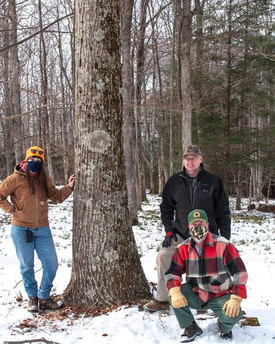 We have a new state champion! A few weeks ago, I travelled to private property to conclusively identify a suspected American chestnut. I got confirmation this morning that it is in fact the largest living American in West Virginia! This tree has beautiful timber form and bark that looks so much like a Northern red oak that I almost passed it. It also has beautiful orange, hairless twigs with orange buds unlike Chinese chestnut which has yellowish to green twigs and buds with lots of tiny hairs. The leaves on this American also have a "crashing wave" shape to the serrations and long, slender, papery, hairless leaves as opposed to the wide, pointier, more squat hairy leaves of its Chinese counterpart. As most of you know, the American chestnut was decimated by a fungal disease known as chestnut blight in the early to mid-1900s. Once growing to be 120 feet tall and up to 13 feet in diameter, according to Gifford Pinchot, finding finding tree over 25 feet now is a rarity, so you can imagine my excitement upon seeing this 80-ft monster. Luckily, this tree exhibited no signs of blight. We suspect this to be an "escape" tree, which means it likely doesn't have any blight resistance, but rather has been lucky to live far enough away from other chestnuts to have escaped infection. As a forest pathology research assistant at WVU, and someone who has worked on chestnut blight for a long time, I belong to and work closely with The American Chestnut Foundation. I'm even the reigning WV Chapter Mrs. Chestnut! TACF is aware of this tree and we will likely be collecting pollen and scion for their breeding programs this year. The landowner is incredibly generous and has kindly offered the material and his help. The Leopold Conservation Award Program recognizes and celebrates extraordinary achievement in voluntary conservation by agricultural landowners. Sand County Foundation, our national sponsor American Farmland Trust, and conservation partners across the U.S. present the prestigious honor, which consists of $10,000 and a crystal award, in settings that showcase the landowners’ achievements among their peers. The Leopold Conservation Award program widely shares the stories of these conservation-minded farmers, ranchers, and forestland owners to inspire countless other landowners to embrace opportunities to improve soil health, water resources and wildlife habitat on their working land. Finally, the program builds bridges between agriculture, government, environmental organizations, industry and academia to advance the cause of environmental improvement on private land. Watch this video to learn more about the Leopold Conservation Award. NOMINATION DEADLINE: MARCH 31, 2024
 KAEE is seeking an enthusiastic and creative educator to fulfill the position of Program Director - someone with a passion for our mission and a desire to help them grow as an organization. This is a full-time, remote position serving Kentucky’s community of environmental educators. If you like to be challenged, learn a lot, have a significant impact, and work with an amazing team, you're encouraged to apply! KWOF selected Jason Ronald Brown as its 2023 scholarship award recipient. Join us at the Annual Meeting in March as we recognize Jason for his outstanding work.
Annually, the Kentucky Woodlands Owners Foundation Scholarship provides an award to an outstanding student enrolled in the University of Kentucky’s professional forestry degree program. The award is granted based on leadership potential, connection with the forestry community, and insight into the forestry profession. |
Archives
July 2024
Categories |
||||||||||||||||||||
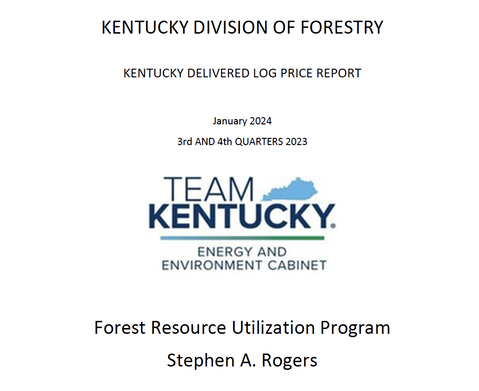
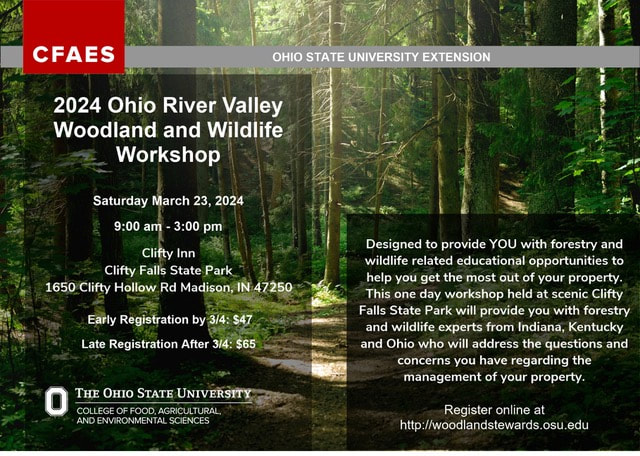
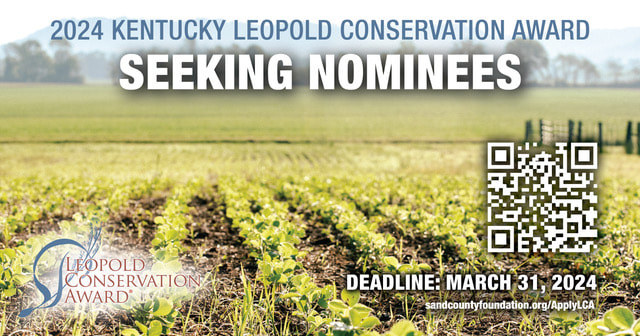
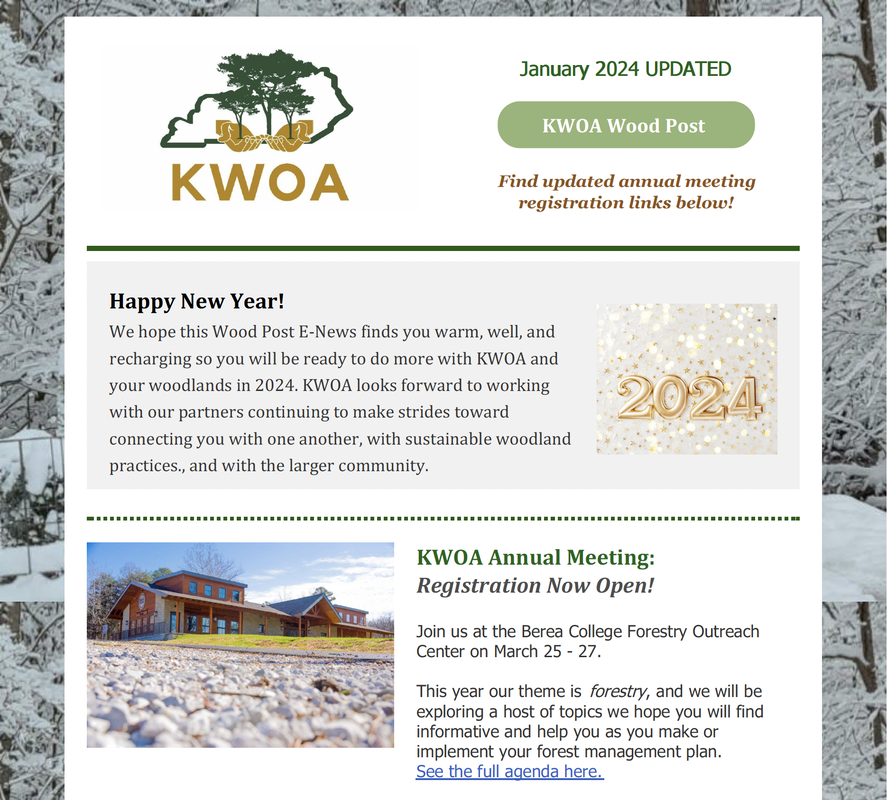
 RSS Feed
RSS Feed